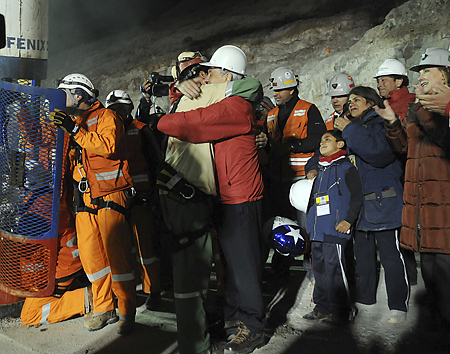
Chilean miner Florencio Avalos is embraced by President Sebastian Pinera as his wife Monica and son Laino wait, after he reached the surface as the first of the 33 trapped miners to be hoisted to safety, at the San Jose mine in Copiapo in this October 12, 2010. (Photo: Manuel de la Maza / Reuters)
When 33 Chilean miners were rescued last year after spending 70 days trapped deep underground, the scenes of those laborers standing as equals with their billionaire President, Sebastián Piñera, seemed to inspire a national resolution: to improve Chile’s historically lousy treatment of its workers. Despite being one of Latin America’s most developed nations, Chile still has some of the region’s worst economic inequality. Fixing that, Piñera told me some weeks after the rescue, would be job número uno. “We need a new culture of worker dignity,” he said, “starting with closing the giant gap between rich and poor, so we don’t have people living on two distinct planets.”
To his credit, Piñera has taken real steps toward those ends, including his Ethical Family Income program and mining safety reforms he signed last month. Mining accidents this year, in fact, are down by more than half. But this past week, as the first anniversary of the mine collapse that entombed “los 33” arrived on Friday, August 5, Planet Chile still looked convulsed by its wealth gap – especially concerns that funding of and access to the nation’s education system remain inordinately skewed to benefit the most affluent. Students and police had violent street clashes in the capital, Santiago, and a department store, La Polar – which has confessed to secretly raising customers’ credit card interest rates to conceal its massive debts – was torched in the melee.
Piñera has fired his education minister and pledged massive new investment in public education and universities. Nonetheless, his approval rating – a new poll this week set it at 26% – has caved in as dramatically as the San José gold and copper mine in northern Copiapó where the miners worked, and where Piñera attended commemoration ceremonies on Friday.
(See “After the Miners’ Triumph: How Chile’s President Lost His Mojo”)
As for the miners, despite being feted at home and abroad, doctors and friends say many of them are mired in their own troubles, psychological and financial. When TIME profiled the men for our Person of the Year issue last December, most confessed to having a hard time sleeping at night, and a number of them hinted at economic difficulties. When we first arrived per our appointment to see Edison Peña, who had sung Elvis Presley songs on the Letterman show during a visit to New York, his wife turned us away because he was having trouble adapting to mood medications. Another, Samuel Avalos, said sarcastically as he pointed to the severe dental problems he developed underground, “I’d like to smile for you, but I can’t pay to get my teeth fixed yet.”
(See Time’s Person of the Year photo portraits of the Chilean miners)
At first it seemed los 33 would have little problem cashing in on their global celebrity. Almost as soon as they emerged from the San José mine last October, a Chilean mining executive donated almost $1,000 to each man. They made a pact not to talk to the media about what they’d endured underground, in order to ensure they’d be the ones to profit from their story. They attended seminars on how to endorse products. And they recently signed up with the legendary Hollywood talent agency, William Morris, to secure book, movie and other rights.
But for now the boon has yet to materialize. William Morris did not return TIME’s calls to determine what if any deals are in the works. About half the miners are negotiating pensions with the government, which will probably amount to about $450 a month. (Chile’s minimum wage is about $300 a month.) But 31 of them, including shift foreman Luis Urzúa, sued the Chilean government last month for almost $17 million because of the mine conditions that led to their ordeal. (They were quick to note, however, that they weren’t suing Piñera, whose efforts they acknowledge were key to their rescue.)
Many of the miners have adjusted well. Like soldiers in combat, they’ve responded to their post-traumatic stress with differing degrees of success and failure. When I talked with Darío Segovia last December, for example, it was obvious that his long tenure as a miner – he’d been doing it since he was a boy – had made his hide tougher to withstand what los 33 suffered. He seemed to shrug off any concerns about his own situation and instead told me, “With all my heart, I lament all the miners who didn’t survive in the New Zealand and China and U.S. [mining] accidents” of 2010. Not surprisingly, according to the Daily Telegraph, Segovia today “is happily running a fruit and vegetable stall” in Copiapó.
But for too many of the other 32, Friday’s anniversary wasn’t just a reminder of the 17 days they spent entirely cut off from the world in the bowels of the earth, when they all but gave themselves up for dead and survived on daily spoonfuls of tuna fish. (Authorities located them on August 22.) It was also an occasion to wonder what happened to all the economic well-being they thought awaited them once they’d escaped their gold mine.
(See “Lessons From the Chile Mine Rescue: What Underdogs Can Teach Us”)

